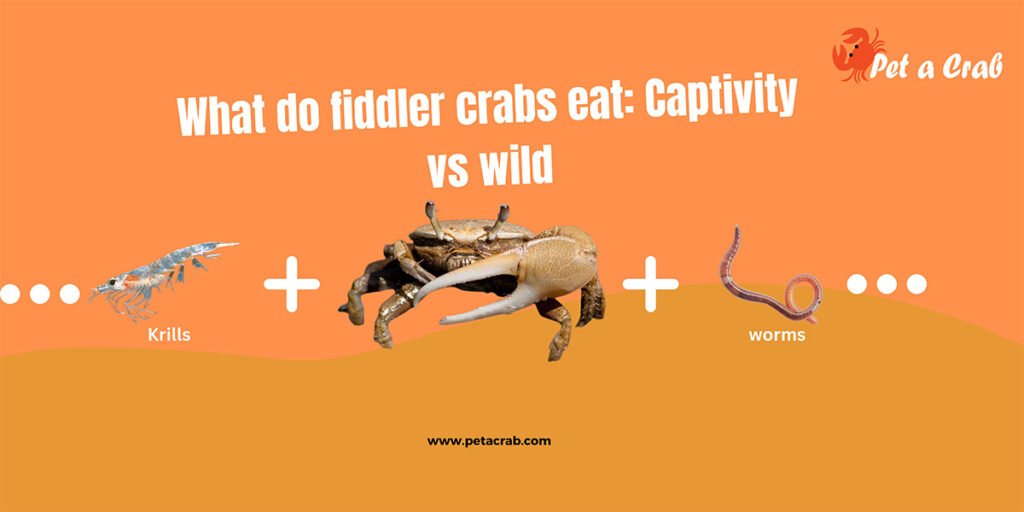The yellow tip hermit crab is one of the hardy marine hermit crab species and works as a tank cleaner by eating algae and leftover food. This crab can be a great addition to your reef tank along with invertebrates and fish. Yellow tip hermit crabs are very easy to care for and they’ll need no extra attention other than very basic maintenance. Here you’ll learn everything you need to know about yellow tip hermit crabs.

Quick overview of yellow tip hermit crab
| · Care Level | Easy |
| · Scientific name | Clibanarius virescens |
| · Distribution | South Africa, Indo-Pacific region, Australia, Japan, Fiji, Vietnam |
| · Temperament | Peaceful |
| · Breeding | Nearly impossible in captivity |
| · Size | Up to 2 inch |
| · Optimal temperature | 72-82° F |
| · Diet | Omnivorous |
| · Sleeping nature | Nocturnal |
| · Life span | 2 – 4 years |
| · Reef compatible | Yes |
Interesting facts about yellow tip hermit crab
- They live in intertidal areas with coral, sand and rock substrates in the wild.
- The female yellow tip crabs usually breed by indirect sperm transferred by the males. The males transfer spermatophores or sperm packets to the female using specialized appendages; then the females store the sperm until they are ready to fertilize. The breeding process is quite difficult and that’s why creating the same environment as the wild and breeding them in captivity is very difficult.
- Ritual behavior can be seen among yellow tip hermit crabs. Before mating occurs, these crabs often engage in some behaviors aiming to attract and select mates. These rituals involve both Olfactory (chemical signals) and Tactile (Physical contact like touching or dancing) cues.
- They work as a “clean-up crew” in the aquarium living at the bottom of the tank and do not cause any harm to the reefs. The small size of the dwarf hermit crabs allows them to crawl into the corner where other invertebrates can’t reach.
- Sometimes they may try to attack snails to take over their shells; so ensure they have access to plenty of shells.
- They have dark green to black bodies with orange or green antennae and yellow bands on their legs which look eye pleasing in the aquarium.
- Yellow tip hermit crabs can tolerate small water parameter changes but they can’t tolerate copper based medication like Cupramine.
- Their antennas are very active you may always see them active.

Dwarf yellow tip hermit crab care
Tank setup
If you already have an aquarium where you want to add them as tank cleaners, ensure the tank condition matches their requirements; or else, they may not survive for long.
Tank size
They are very social creatures; love to hang with the same species and need a lot of space to crawl around. Take a minimum 20-gallon tank for a group (5 or 6) of crabs. Clean the tank properly ensuring there is no bacteria.
Substrate
You can use normal sand as substrate but ensure the layer of substrate is deep enough to burrow and hide. You can use a mix of gravel; ensure the grains are small and not sharp. The gravels will help in the aeration system ensuring the sand is not sticky.
Decoration
Use aquarium rocks to make plenty of hideouts. Place any reefs or anemones you want; they will love it. You can place saltwater plants like halimeda, red mangrove, mermaid’s fan, green finger plant and hypnea but it is optional as plants don’t play any role mimicking their natural habitat.

Temperature and water parameters for yellow tip hermit crab
Dwarf yellow tip hermit crab requires temperatures between 72-82° F and 3-5° F -+ will not cause any problem if the other requirements are okay. Be sure you are using a thermometer to monitor the temperature.
Yellow tip hermit crabs typically require the following water parameters for optimal health:
- dKH (carbonate hardness): 8-12
- Specific Gravity (sg): 1.023 to 1.025
- pH Level: 8.1 to 8.4
Light and shell requirements
Like other hermit crab species, the movements of yellow tip hermit crabs can be seen at night as they are nocturnal. I’m assuming your aquarium doesn’t get natural light, if does then there is nothing to think about lighting.
The crabs will need day and night cycles mimicking the natural time, consider maintaining at least 12 hours of the day and 12 hours of the night. A basic LED bulb for an aquarium, what you can find in pet stores is enough.
As the crabs grow they need gastropod shells to move on which fit best in their body, changing shells can happen without molting or other reasons like being uncomfortable in the previous shell, parasite or any other object disturbing in the previous one and they may find a better one. Shell unavailability can lead to aggression and fighting with other hermit crabs or snails. So ensure they have different sizes of shells available in the tank; minimum 15-20 for a group of 5-6 crabs

Yellow tip hermit crab feeding
- Yellow tip hermit crabs are omnivorous meaning they can eat anything but they mostly depend on algae and biofilm found on live rocks and tank surfaces. Ensure there is enough algae growth in the tank for them.
- They also eat uneaten food fallen on the bottom of the tank and feces of fish and other tank mates.
- Additionally, you have to give them high-quality sinking pellets specially designed for marine invertebrates. You can easily find a variety of commercial food in local and online stores.
- Supplement their diet with protein sources like fish, shrimp or mussels and Calcium sources like cuttlebone as calcium helps them have healthy exoskeleton growth.
- Fresh fruits and vegetables are not necessary but if the crabs like, you can give 2 to 3 times a week. First, start with a small amount if they like then continue or else you can skip.
Tank mates of yellow tip hermit crab
You have to choose small and peaceful tank mates so that they don’t feel threatened. Small snails should be kept with caution. If you feel the tank is crowded then move to a bigger one because they don’t like crowded tanks. Here is a list of a few tank mates for yellow tip hermit crabs.
- Arrow crab
- Clownfish
- Blue leg and polka dot hermit crab
- Serpent starfish
- Peppermint shrimp
Related article- The fascinating ghost crab.


